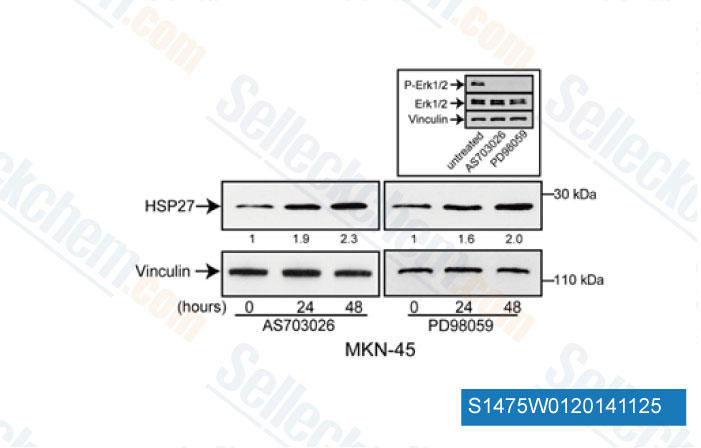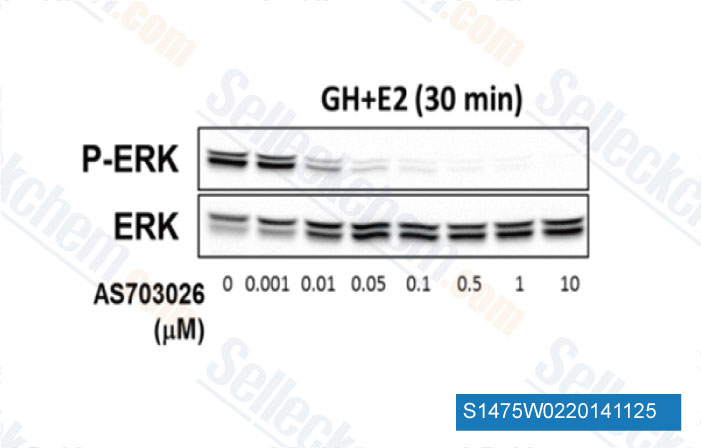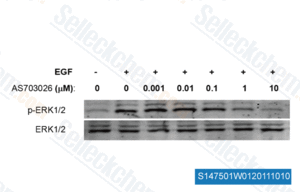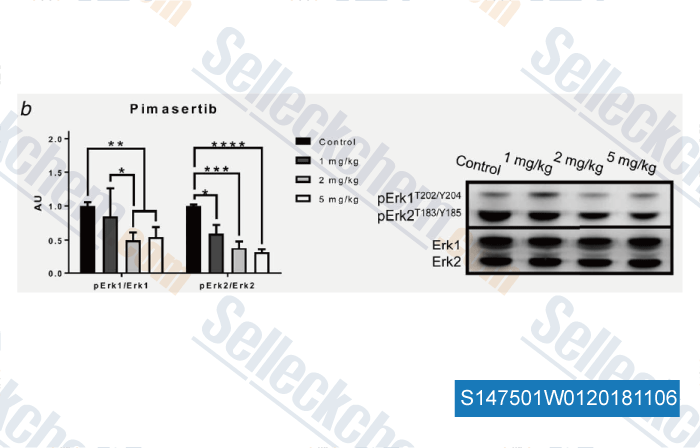|
Toll Free: (877) 796-6397 -- USA and Canada only -- |
Fax: +1-832-582-8590 Orders: +1-832-582-8158 |
Tech Support: +1-832-582-8158 Ext:3 Please provide your Order Number in the email. |
Technical Data
| Formula | C15H15FIN3O3 |
||||||||||
| Molecular Weight | 431.20 | CAS No. | 1236699-92-5 | ||||||||
| Solubility (25°C)* | In vitro | DMSO | 86 mg/mL (199.44 mM) | ||||||||
| Water | Insoluble | ||||||||||
| Ethanol | Insoluble | ||||||||||
| In vivo (Add solvents to the product individually and in order) |
|
||||||||||
|
* <1 mg/ml means slightly soluble or insoluble. * Please note that Selleck tests the solubility of all compounds in-house, and the actual solubility may differ slightly from published values. This is normal and is due to slight batch-to-batch variations. * Room temperature shipping (Stability testing shows this product can be shipped without any cooling measures.) |
|||||||||||
Preparing Stock Solutions
Biological Activity
| Description | Pimasertib (AS-703026, MSC1936369B, SAR 245509) is a highly selective, potent, ATP non-competitive allosteric inhibitor of MEK1/2 with IC50 of 5 nM-2 μM in MM cell lines. Phase 2. | ||
|---|---|---|---|
| Targets |
|
||
| In vitro | AS703026 is a novel, selective, orally bioavailable MEK1/2 inhibitor that binds to the distinctive MEK allosteric site and therefore exhibits exquisite kinase selectivity. AS703026 inhibits growth and survival of human multiple myeloma (MM) cells, including U266 and INA-6, with IC50 of 5 nM and 11 nM, respectively. Such an inhibitory effect by AS703026 is mediated by G0-G1 cell cycle arrest and is accompanied by reduced expresson of the MAF oncogene. AS703026 further induces apoptosis via caspase-3 and PARP cleavage in MM cells, both in the presence or absence of bone marrow stromal cells (BMSCs). [1] AS703026 may be an effective therapy in colorectal cancer caused by K-Ras mutation. AS703026 (10 μM) effectively inhibits the ERK pathway, proliferation, and transformation in human DLD-1 colorectal cancer cells what carry a mutant allele of K-Ras (D-MUT). [2] | ||
| In vivo | AS703026 (15 and 30 mg/kg) significantly inhibits tumor growth in a human plasmacytoma xenograft model of H929 MM cells. This can be correlated with downregulated pERK1/2, induced PARP cleavage, and decreased microvessels. [1] AS703026 (10 mg/kg) inhibits tumor growth, and markedly decreases p-ERK level in a xenograft mouse model of human K-Ras mutated (D-MUT) colorectal tumor. [2] | ||
| Features | A novel, highly selective and potent allosteric inhibitor of MEK1/2. |
Protocol (from reference)
| Kinase Assay:[3] |
|
|---|---|
| Cell Assay:[1] |
|
| Animal Study:[1] |
|
References
|
Customer Product Validation

-
Data from [Data independently produced by FASEB J, 2014, 10.1096/fj.13-247924]

-
Data from [Data independently produced by Endocrinology, 2013, 154(9), 3219-27]

-
, , Dr. Zhang of Tianjin Medical University

-
Data from [Data independently produced by , , Int J Cancer, 2018, 142(2):381-391]
Selleck's Pimasertib (AS-703026) has been cited by 47 publications
| ATP1A1 is a promising new target for melanoma treatment and can be inhibited by its physiological ligand bufalin to restore targeted therapy efficacy [ Cancer Cell Int, 2024, 24(1):8] | PubMed: 38178183 |
| Salmonella effector SopB reorganizes cytoskeletal vimentin to maintain replication vacuoles for efficient infection [ Nat Commun, 2023, 14(1):478] | PubMed: 36717589 |
| ETS1 phosphorylation at threonine 38 is associated with the cell of origin of diffuse large B cell lymphoma and sustains the growth of tumour cells [ Br J Haematol, 2023, 10.1111/bjh.19018] | PubMed: 37584198 |
| Three generations of mTOR kinase inhibitors in the activation of the apoptosis process in melanoma cells [ J Cell Commun Signal, 2023, 17(3):975-989] | PubMed: 37097377 |
| Three generations of mTOR kinase inhibitors in the activation of the apoptosis process in melanoma cells [ J Cell Commun Signal, 2023, 17(3):975-989] | PubMed: 37097377 |
| A Cell Cycle-Dependent Ferroptosis Sensitivity Switch Governed by EMP2 [ bioRxiv, 2023, 2023.07.19.549715] | PubMed: 37502927 |
| Anatomic position determines oncogenic specificity in melanoma [ Nature, 2022, 604(7905):354-361] | PubMed: 35355015 |
| Identification of New Vulnerabilities in Conjunctival Melanoma Using Image-Based High Content Drug Screening [ Cancers (Basel), 2022, 14(6)1575] | PubMed: 35326726 |
| Mcl-1 and Bcl-xL levels predict responsiveness to dual MEK/Bcl-2 inhibition in B-cell malignancies [ Mol Oncol, 2021, 10.1002/1878-0261.13153] | PubMed: 34861096 |
| Pharmacologically controlling protein-protein interactions through epichaperomes for therapeutic vulnerability in cancer [ Commun Biol, 2021, 4(1):1333] | PubMed: 34824367 |
RETURN POLICY
Selleck Chemical’s Unconditional Return Policy ensures a smooth online shopping experience for our customers. If you are in any way unsatisfied with your purchase, you may return any item(s) within 7 days of receiving it. In the event of product quality issues, either protocol related or product related problems, you may return any item(s) within 365 days from the original purchase date. Please follow the instructions below when returning products.
SHIPPING AND STORAGE
Selleck products are transported at room temperature. If you receive the product at room temperature, please rest assured, the Selleck Quality Inspection Department has conducted experiments to verify that the normal temperature placement of one month will not affect the biological activity of powder products. After collecting, please store the product according to the requirements described in the datasheet. Most Selleck products are stable under the recommended conditions.
NOT FOR HUMAN, VETERINARY DIAGNOSTIC OR THERAPEUTIC USE.
